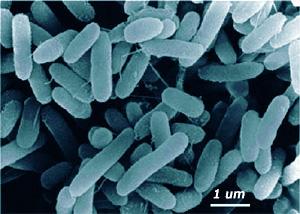Marinobacter aquaeolei VT8 (Model bacterium for neutral lipid biosynthesis)
Ideal study of biosynthetic processes requires the utilization of a model system. For our studies of neutral lipid biosynthesis, we have chosen the marine bacterium Marinobacter aquaeolei VT8. This specific bacterial strain was isolated from an oil platform off the coast of Vietnam. It is a Gram-negative rod shaped Proteobacterium. We have been working with the strain for many years now, and have cloned a range of genes from this species and characterized the enzymes involved in the production of wax esters
This species was part of the initial effort to sequence a broad range of bacterium. Because of this, we have had a sequence of the entire genome of M. aquaeolei VT8 for some time. Other key resources related to this species are provided below.
- Joint Genome Institute (JGI) page for M. aquaeolei VT8
- KEGG genome site for M. aquaeolei VT8
- MicrobeWiki site for M. aquaeolei VT8
- PubMed link to initial paper describing the isolation of M. aquaeolei VT8
- PubMed link to paper describing genome insights of the “opportunitroph” M. aquaeolei VT8
- Why M. aquaeolei VT8 was sequenced by the Department of Energy
Specific features of this strain and why we selected M. aquaeolei VT8 as a model species in our laboratory are described below:
- M. aquaeolei VT8 is a non-pathogenic bacterium that is ubiquitous in nature and is also a halophile capable of growing at very high salt concentrations (above 1.0 M NaCl). This aspect may be important in situations where freshwater may not be immediately available or in applications where one desires to minimize potential contamination from competing strains.
- M. aquaeolei VT8 can grow on a range of “contaminating” compounds found in crude oil and convert these to safer biofuels such as wax esters. M. aquaeolei VT8 has been found as part of the consortium of bacteria growing in numerous oil spill sites, including multiple sites related to the Deepwater Horizon oil spill
- M. aquaeolei VT8 can be grown on very simple defined media including simple hydrocarbons or TCA cycle intermediates such as citrate and succinate, so that biosynthesis of unique compounds can be easily tracked during growth.
- We have developed a range of genetic techniques that allow us to integrate or remove genes from M. aquaeolei VT8 using antibiotic selection and counter selection protocols, so that multiple gene modifications can be achieved without the need for multiple antibiotic markers. In this manner, we can introduce any number of stable deletions, add foreign genes to modify pathways or alter regulatory elements to control expression. These genetic tools make it possible to achieve any modifications possible in other model bacteria such as E. coli in M. aquaeolei VT8.
- M. aquaeolei VT8 naturally accumulates high yields (in terms of weight percent) of internal neutral lipids, similar to what is found in many microalgae and is also reported to export lipids out of the cell, which would improve potential isolation approaches.
- We have developed a range of techniques to analyze the neutral lipid profile biosynthetically produced by M. aquaeoleiVT8 to measure the effect on wax production following various genetic alterations. These techniques can be applied to intracellular or extracellular lipids.
- Enzymes obtained from the M. aquaeolei VT8 strain have shown significantly higher activity than enzymes obtained from other neutral lipid accumulating bacteria such as Rhodococcus and Acinetobacter, which allows us to pursue broader enzymatic studies in the laboratory.
- Recent progress has been made showing the potential to shift product profiles of several key enzymes involved in biosynthetic hydrocarbon production.
- Various strains of Marinobacter have been found associated with a range of additional organisms, often forming symbiotic relationships. Thus, we believe that progress made with this strain could lead to potential applications usingMarinobacter as part of a larger community.
- Certain aspects of M. aquaeolei VT8 make it a much better model system to study potential “lipid triggers” that are of interest to many in the biofuel community. Our recent efforts have made substantial progress toward preliminary studies of gene regulation during lipid accumulation as well as during lipid degradation following the initial neutral lipid accumulation process.
- Lipid accumulation in M. aquaeolei VT8 occurs during a stage of growth when the organism is no longer replicating, and the strain is known to form biofilms. These aspects make it ideal for the optimization of specific pathways that will devote resources to fuel biosynthesis.
